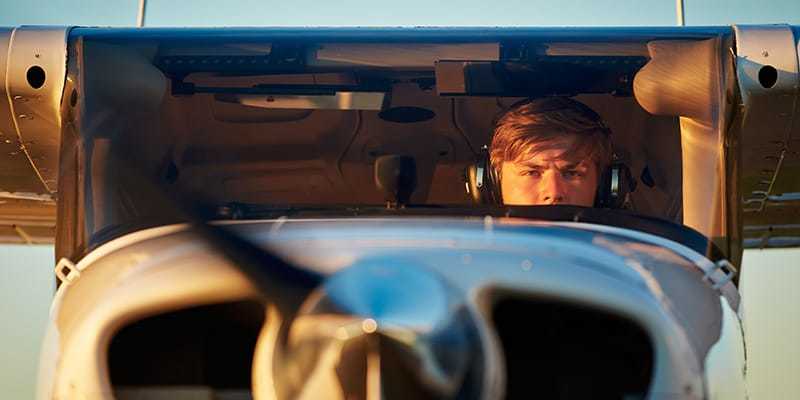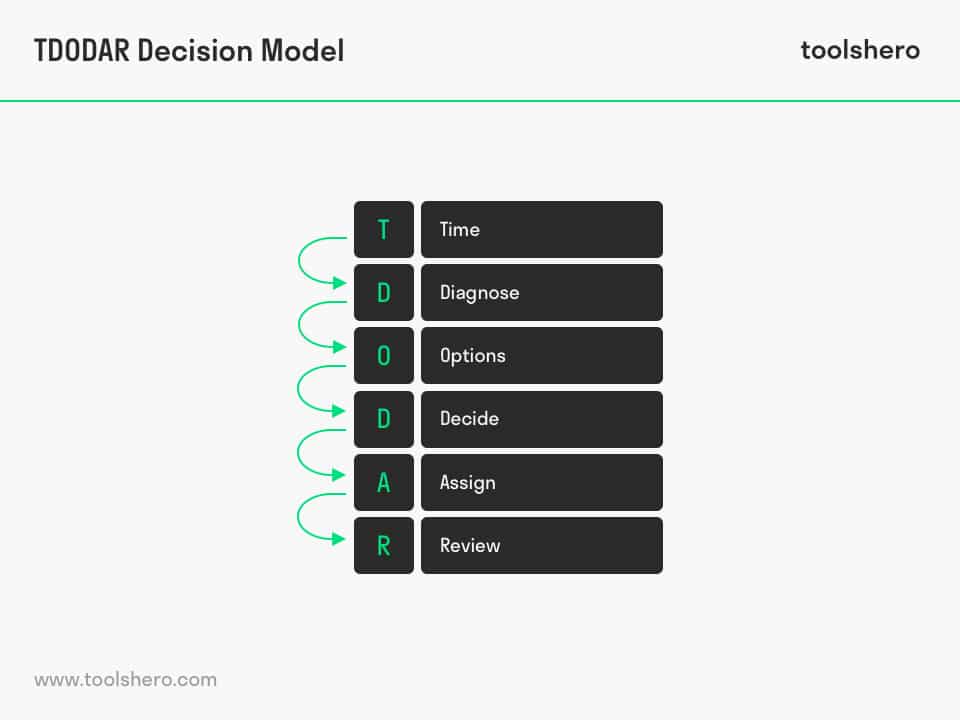TDODAR Decision Making Model

TDODAR decision making model: this article provides a practical explanation of the TDODAR decision making model. After reading, you’ll have a basic understanding of this powerful decision-making tool.
What Is the TDODAR Decision Making Model?
The TDODAR decision making model is a model that is predominantly used in aviation. It helps pilots make decisions in threatening situations. The model, predominantly used by British pilots, does this by having the pilot follow a step-by-step plan. These six steps consist of: time, diagnosis, options, decide, assign, and review.
The TDODAR decision making model is excellently suitable for making well-considered decisions in situations in which it’s unclear what exactly must happen. Decision making can be influenced by a great number of factors.
Pilots experience factors such as stress, time pressure, perceptions, experience, and knowledge in different situations. Particularly in aviation, the stakes are high and all options must be considered before decisions are made.
The TDODAR decision making model might also come in handy in situations on the ground. For instance, it could help managers to refrain from making hasty or incorrect decisions, and offers them an instrument to give structure and discipline to the decision-making process.
Failure / Error Management
There are various tools for decision making in aviation, and multiple tools are also actually used in the airplanes. However, the principles are easy to understand and are also applicable to situations at work.
The application to management is explained in the next chapter. The process remains the same, but when using TDODAR in aviation, several circumstances must be checked. These are:
- Autopilot is active
- The plane is flying above the minimum safe altitude
- All checklists for management have been completed
- Both pilots are ready and focused on the process for decision making
When these conditions are met, the pilots can move to the TDODAR decision-making process.
Steps TDODAR decision making model
The TDODAR decision making model must generally be carried out by the plane’s captain, or the manager on the workfloor. Characteristic of a successfully conducted TDODAR process is:
- All steps must be carried out individually to discover all errors
- The manager leads the TDODAR, but the assistant manager could bear responsibility for the first steps
- The process is conducted as concisely and efficiently as possible due to the time pressure that exists in these situations.
- When the manager takes charge, he must explicitly inform the assistant manager that he is in charge
1. Time
Time is crucial in emergency situations, both on an airplane and on the ground. Here, time refers to the manager or captain determining how the further process is conducted. It is possible that important steps are skipped due to time pressure.
When the production line stagnates in a production company, the manager uses the first component of the TDODAR decision making model to determine how long it takes before the production line is up and running again before the time plan is compromised.
The time available to solve the problem is limited by:
- Severe technical failures
- Fire
- Fuel
- Loss of pressure
2. Diagnose
The managers or pilots probably have an idea of the problem’s cause when noticing the problem. Nevertheless, a diagnosis must still be set. It is important two managers communicate properly.
The manager asks the assistant manager: ‘what do you think the problem is?’ The assistant manager says: ‘I believe the compressor at the beginning of the production line is broken, and this negatively impacts the entire production line’. ‘Why?’, the manager asks. The assistant answers: ‘on my control panel, I can see that the fuse of this compressor is broken, which results in stagnation of the entire production line.’
3. Options
It’s important to come up with and present as many solutions as possible for a certain problem. In an airplane, there are many possible causes for one specific problem, and when the electronics fail, it might be difficult to discover the exact cause.
Generally speaking, there are three options in case of failures or other problems, such as a medical emergency, on an airplane: back to the airport of departure, to the nearest airport, or to the destination airport.
On the workfloor, the following can be considered: renewing the fuse without ascertaining the cause, ascertaining the cause and a new fuse, or halting production. Often, an emergency situation does not allow for a risk analysis to explore the various options.
4. Decide
In this step of the TDODAR decision making model, the manager or captain takes charge of the decision-making process, based on the information gained in the previous steps.
5. Assign
After it is decided which option must be used to solve the problem, it’s the manager’s duty to manage the situation and assign specific tasks to the right people.
If the manager decides to resolve an emergency situation himself, he transfers the responsibility for all other operational processes to the assistant manager.
In an emergency situation in a passenger plane, the pilot or captain informs the passengers of the situation and the final checklists are carried out.
6. Review
When both pilots or both managers start carrying out their tasks, the work pressure increases.
In addition to their regular tasks, they now also have to carry out various other activities to control the emergency situation. This step must be carefully conducted when time allows this.
If there is a moment when both pilots have nothing to do, or when both managers have time to reflect, a review is carried out.
In the review, it is explored whether there are any abnormalities, and whether the problem has been solved or suspended as efficiently as possible.
Focus Areas TDODAR decision making model
An effective and precise TDODAR process reduces the chance of bad information due to biases, assumptions, and overconfidence.
By asking good and direct questions, the manager or pilot is able to obtain a careful and untainted analysis from the captain or other authority figure. It is also important that both managers or pilots do not share their personal perception of the situation, until the moment the diagnosis must be set.
A rule in decision making for aviation is that, when a pilot believes in a more conservative solution, this option is generally selected. The reason for this rule is to prevent overconfidence.
The TDODAR decision making model is effective and useful in situations with a high level of uncertainty. The model has no added value if there is no uncertainty or doubt concerning the steps to be taken, or when there is no time pressure.
The danger of TDODAR lies in the fact that the steps taken after the diagnosis has been set, determine whether the crew is on the right track. If the diagnosis was incorrect and the problem still occurs, the complexity of the situation will only increase.
In the business world, pressure and the risks are high, but in aviation, human lives are at stake. For this reason, the time pressure is an important element in this process.
Now It’s Your Turn
What do you think? Are you familiar with the explanation of the TDODAR decision making model? What do you think are the pros and cons of using this model? How do you believe this model from aviation can be applied in the business world? Have you encountered emergency situations or calamities in which such a procedure was carried out? Do you have any tips or additional comments?
Share your experience and knowledge in the comments box below.
More information
- Helmreich, R. L. (2000). On error management: lessons from aviation. Bmj, 320(7237), 781-785.
- Moriarty, C. D. (2014). Practical human factors for pilots. Academic Press.
- Reason, J. (2000). Human error: models and management. Bmj, 320(7237), 768-770.
- Zsambok, C. E., & Klein, G. (Eds.). (2014). Naturalistic decision making. Psychology Press.
How to cite this article:
Janse, B. (2019). TDODAR Decision Making Model. Retrieved [insert date] from toolshero: https://www.toolshero.com/decision-making/tdodar-decision-making-model/
Published on: 04/11/2019 | Last update: 05/20/2022
Add a link to this page on your website:
<a href=”https://www.toolshero.com/decision-making/tdodar-decision-making-model/”>toolshero: TDODAR Decision Making Model</a>







